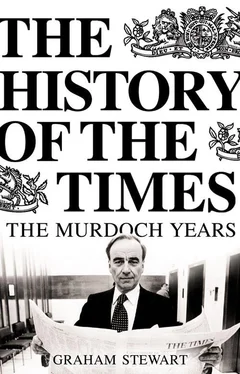But while he had won the vote, not everyone was convinced his case had won the argument. Although he would soon accept Murdoch’s shilling, Harold Evans wrote Aitken a letter congratulating him on his speech. [83] Jonathan Aitken to the author, interview, 27 May 2003.
There was a widespread belief that it had all been a stitch-up. Aitken had alleged that Thomson had suspiciously ignored several serious bids because it had already decided upon Murdoch. But were the names Aitken reeled off superior bidders? Rees-Mogg himself thought Murdoch a better option than his own consortium. Atlantic Richfield was about to move out of British newspaper ownership. Associated Newspapers could not guarantee The Times ’s future. The idea that the editorial independence of the paper would be in safer hands with Lonhro’s Tiny Rowland was, as the Observer would later discover, highly contestable. If Brunton had pre-judged Murdoch’s suitability over these alternatives, might it not have been on the basis of an honest assessment of who offered the best future – perhaps the only future – for The Times ? And if Lord Roll was a ‘banker of fees’ would he not have urged acceptance of the far higher bid from Rothermere’s Associated Newspapers?
The controversy was kept alive when, only a month after Biffen had made his statement in the Commons, the American oil company Atlantic Richfield sold the troubled Observer to Outrams, a subsidiary of Tiny Rowland’s Lonhro Group. Given that the Glasgow Herald was the closest Outrams/Lonhro could claim to owning a national newspaper, Biffen’s decision to refer the bid to the Monopolies Commission appeared perverse. Memorably dubbed by Edward Heath the ‘unacceptable face of capitalism’, Rowland had made himself objectionable to conservatives, socialists and liberals in equal measure and could find fewer defenders than Murdoch. The manner in which the Observer had been sold to him created unease, for the first that any of the editor-in-chief, the editor or the board of directors knew of it was after the deal had been done. There was also a more clearly defined question of public interest, in particular whether there was a conflict between the Observer ’s extensive coverage of African affairs and Rowland’s business interests there. The Monopolies Commission could find no evidence to assume that it would and permitted the deal to go ahead subject to the installation of independent directors on a model similar to that adopted at Times Newspapers. [84] The Times , 26 February 1981; Alan Watkins, A Short Walk Down Fleet Street , pp. 178–9; Jenkins, Market for Glory , pp. 169–70.
The experience was not to prove a happy one. But in February 1981 there remained many who could not see the consistency in the Government’s handling of newspaper takeovers.
Whatever the political symmetry between the Thatcher Government and Rupert Murdoch, the decision not to refer the TNL purchase was only legally possible on the grounds of the papers’ unprofitability. The Thomson submission to Biffen had claimed, ‘neither The Times nor the Sunday Times are economical as going concerns and as separate newspapers under current circumstances’. [85] Thomson submission to the Department of Trade and Industry.
That The Times was in dire straits was not in doubt. But could that really be said of the Sunday Times , whose problems were hoped to be but temporary?
The TNL statistics sent out by Warburgs to prospective buyers had shown that the Sunday Times had actually scraped into the black in 1980 and by 1983 would be making projected profits of £13 million. John Smith immediately challenged Biffen on these figures since they appeared at odds with the statement he had given to the Commons. Biffen had to concede that he had based the paper’s loss on an estimate of the first nine months of 1980 and not, as MPs had been led to assume, the first eleven. [86] John Biffen to John Smith, 3 February 1981, letter reprinted in The Times , 4 February 1981.
Harold Evans was not alone in resenting the way in which those seeking to avoid a referral had treated his paper. He found that many of his journalists ‘objected to being swept into what they saw as a large, alien publishing group on the sole grounds that it was necessary to save The Times ’. [87] Evans, Good Times, Bad Times , p. 143.
This now became a problem. The NUJ chapel of the Sunday Times decided to challenge Biffen’s non-referral in court. The action could cost £60,000 – a sum that was far beyond the chapel’s reach. Negotiations were opened with Rothermere’s Associated Newspapers to see if they would underwrite the expense. The intermediary was Jonathan Aitken. But Associated were hesitant and, with only thirty-six hours to go before the court hearing, the chapel called off the action following Murdoch’s promise that two working journalists would be appointed to the TNL Holdings board. [88] Ibid., pp. 151–3; Sunday Times , 18 February 1981.
Murdoch could now turn his attention to jumping the final hurdle: agreement with the unions. Historically, he had not been one of the unions’ principal bogeymen. In 1969, they had emphatically preferred his bid for the Sun to that of Robert Maxwell who promised under his ownership a paper that ‘shall give clear and loyal support at all times to the Labour movement’ but who wanted to cut the number employed printing the paper. [89] Jenkins, Market for Glory , p. 58.
Compared to Rothermere who might close The Times , or the Rees-Mogg consortium that wanted to move printing to the provinces, Murdoch seemed the best bet for keeping jobs at Gray’s Inn Road. Because of this, Bill Keys (SOGAT), Joe Wade (NGA) and Owen O’Brien (NATSOPA) had written on the day after Thomson had accepted Murdoch’s provisional bid to Michael Foot, Labour’s Deputy Leader, urging him not to press for a referral to the Monopolies Commission. [90] The Times , 13 February 1981.
The appeal fell upon deaf ears, but it was a positive sign of how they regarded Murdoch.
News International and the unions had until 12 February to agree a deal. A 30 per cent cut in the four thousand jobs at TNL was demanded. If enough voluntary redundancies could not be agreed, compulsory ones would make up the shortfall. There would also have to be a wage freeze until October 1982. Murdoch put two of his most doughty negotiators in charge of the talks. One was John Collier. Collier had been a NATSOPA official, working for the Guardian back in the days when it still retained Manchester in its title. He had joined Murdoch’s News Group Newspapers following its purchase of the Sun , becoming general manager in 1974. He knew how Fleet Street negotiations worked. In contrast, his accomplice had not even set foot in Britain before. But Murdoch had every confidence in the ex-secretary of the Sydney Ten-pin Bowling Association, Bill O’Neill. He had started as a fifteen-year-old apprentice in the composing room of the Sydney Daily Mirror . Like Collier, he had been active in the print union although disgust at the outlook of its pro-Communist officials led him to seek out union responsibilities that were less overtly political. He was still at the Sydney Mirror when its owners, Fairfax, sold it to Murdoch. The new proprietor promptly set about reinvigorating the run-down title in a manner similar to his later strategy at the Sun . By the mid-seventies, O’Neill had switched to the management side. When, in early 1981, Murdoch asked him what he thought of the intention to buy The Times , O’Neill mumbled something about barge poles. Murdoch shot back, ‘it’s obvious you’ve been talking to the wrong people’, and told him that he should expect to be in London for only as long as it took to finalize the deal with the unions there – which he estimated at two weeks. This was one of Murdoch’s less accurate predictions. [91] O’Neill, Copy Out .
Читать дальше












